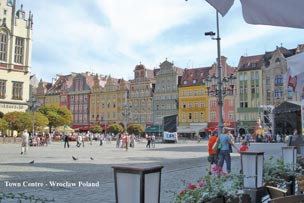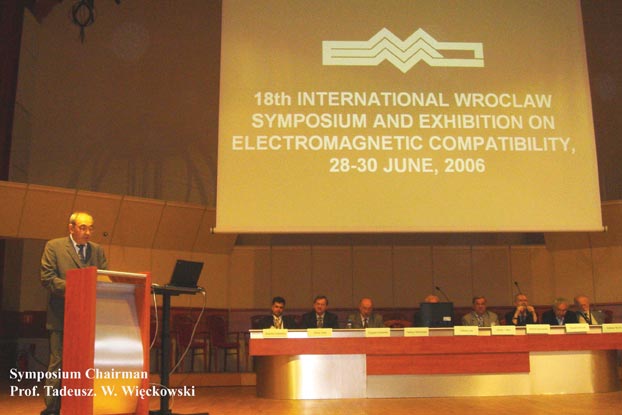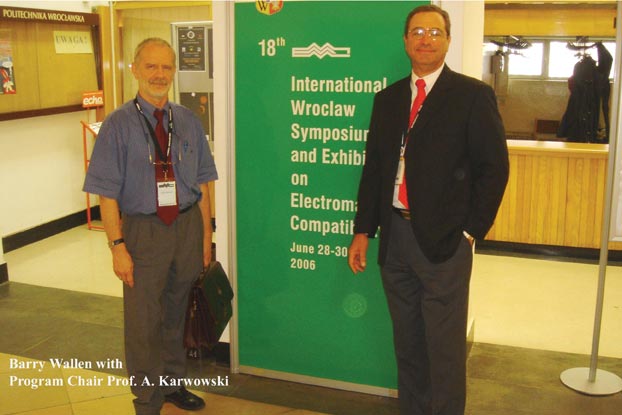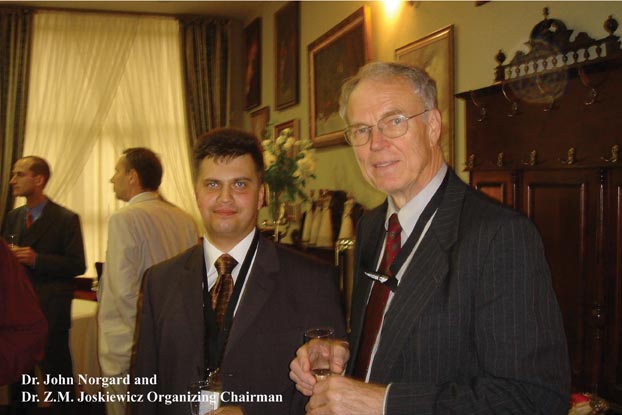 |
| Town Centre - Wroclaw Poland |
It was my first trip to Poland and I really
did not know what to expect. I had known of the Wroclaw (pronounced
vrôt'släf') Symposium for sometime but had never been
able to attend. I arrived in Wroclaw on Tuesday evening and met
up with Dr. John Norgard, EMC Board of Directors Vice-President
for Technical Services. John had already been in the country for
a day and had had a chance to scope out the town and the local
eateries. I dropped my bags and we headed to the Town Centre area
for some dinner and my first surprise.
The Town Centre was a beautiful square, surrounded by brightly
colored buildings. Its central focus was the Town Hall built during
the 14th and 16th centuries.
On Wednesday morning, John and I climbed aboard the Symposium
bus and headed for the conference. We met several members of the
Conference Committee, introduced ourselves and were very warmly
welcomed.
 |
| Symposium Chairman, Prof. Tadeusz
W. Wieckowski. |
 |
| Barry Wallen (right) with Program
Chair, Prof. A. Karwowski. |
The “International Wroclaw Symposium and Exhibition on Electromagnetic
Compatibility” is one of the oldest EMC conferences in Europe.
Below is an excerpt from the Symposium Chairman Professor Tadeusz.
W. Wieckowski’s welcome address given at the beginning of
the conference:
“The Wroclaw EMC Symposium is the oldest European scientific
conference pertaining to electromagnetic compatibility, held regularly
every two years for over 34 years now… From the earliest
days, the Wroclaw EMC Symposium played a special role. It served
as a meeting place and facilitated discussion and presentation
of scientific achievements for scientists from the so-called “Eastern
block” and the rest of the world. The Wroclaw symposium
quickly became a natural bridge between these “two worlds”,
especially considering that at that time the symposium proceedings
were held in English as well as Russian and that conference papers
could also be printed in Russian.
 |
| Dr. John Norgard (right) and Dr.
Z. M. Joskiewicz, Organing Chairman. |
As a result, Wroclaw became a meeting place of people involved
in research of earth natural electromagnetic phenomena: people
working on spectrum engineering, management and monitoring; radio
astronomers fighting for clear spectrum for their observations,
people involved in the EMC measurements; people working in radio
wave propagation and antenna theory; people involved in the technical
side of research of biological hazards of EM radiation; and people
interested in counteracting EM terrorism. Looking at the ongoing
interest proven by continued high attendance, we believe that
this approach has been welcomed by all.
We would like the Wroclaw Symposium to continue to be a meeting
place for all scientists, no matter what borders might be between
them. This is especially important, considering that over these
thirty years our symposium managed to build its own unique identity.
During these years, we always tried to bring together individuals
interested in various aspects of EMC, theory and practical applications,
to enable their interaction, in the belief that new bright ideas
often sparkle on the borders of different fields of activity.”
I believe the symposium achieved the goals of its organizers in
providing a diverse program to a diverse audience. Approximately
200 attendees from all over the world enjoyed 100 papers covering
a broad sampling of EMC and Spectrum Management topics.
In addition to an excellent technical program, the Wroclaw Symposium
Committee treated the attendees to a reception on Wednesday night
and a Barbeque Picnic on Thursday night. The food, drink, and
entertainment were excellent and all had a great time.
The Wroclaw Symposium was an excellent opportunity to meet and
engage with our fellow Society members in Eastern Europe. The
Symposium, the city, and the people made it a memorable experience,
one that I hope to repeat. EMC



